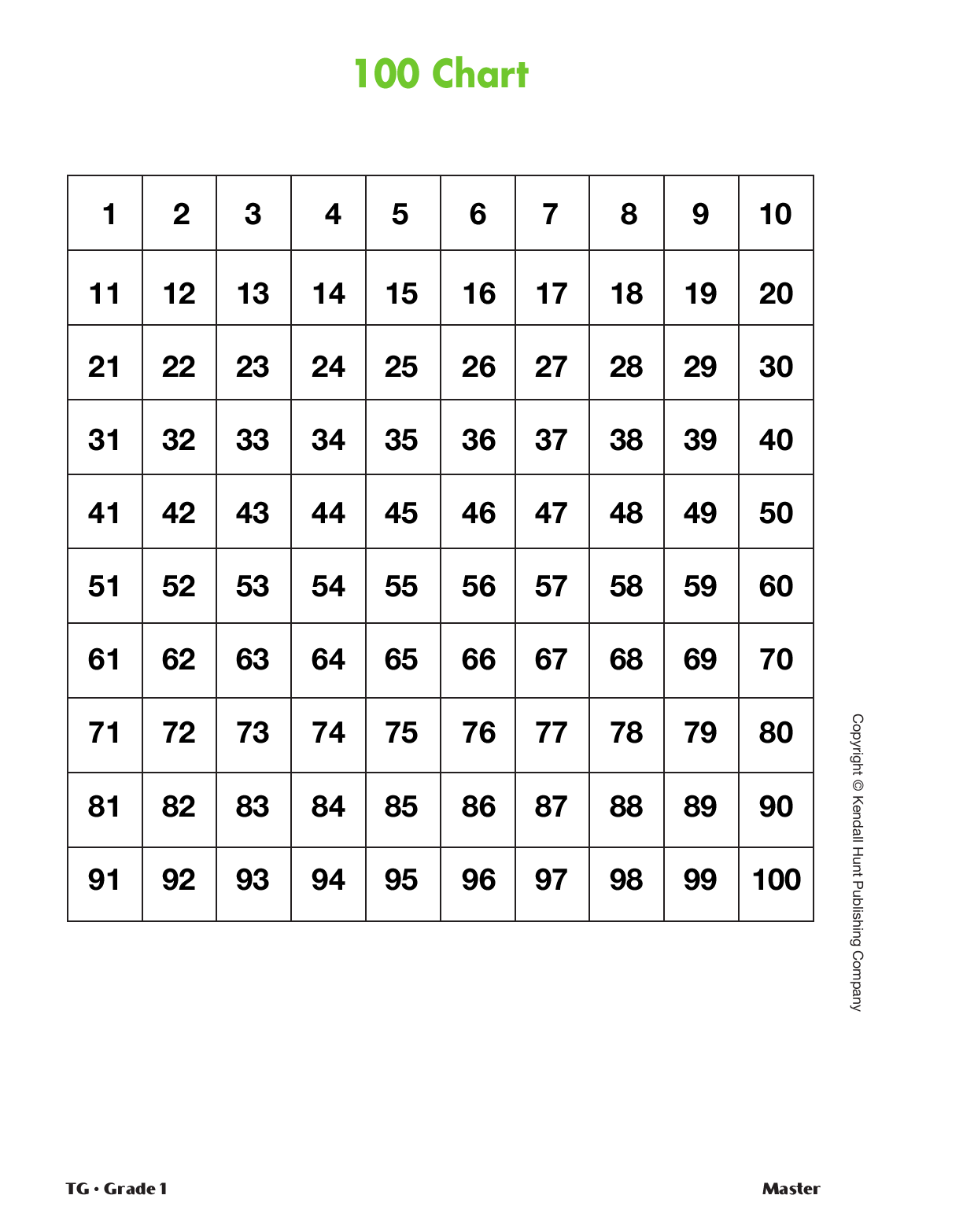Explore Number Relationships on the 100 Chart.
Display and direct students to the 100 Chart from
the Student Activity Book Reference section. Review
what students learned in Unit 10 about moving on
the 100 Chart. See Content Note.
- Start at 56. Find 1 more. (57) Which direction did you move on the 100 Chart? (right)
- What number sentence could you write to show
1 more than 56? (56 + 1 = 57)
- Start at 56. Find 1 less. (55) Which direction did you move on the 100 Chart? (left)
- What number sentence could you write to show
1 less than 56? (56 − 1 = 55)
- Start at 56. Find 10 more. (66) How did you find
the answer on the 100 Chart? (Possible answer: I
moved one row below to 66. Or, I moved one
square at a time to find 10 more.)
- What number sentence could you write to show
10 more than 56? (56 + 10 = 66)
- Start at 56. Find 10 less. (46) How did you find the
answer on the 100 Chart? (Possible response: I
counted back 10. I moved one row above to 46.)
- What number sentence could you write to show
10 less than 56? (56 − 10 = 46)

When talking with students about the numbers on the
100
Chart, model language that emphasizes the relationship among
the numbers (e.g., ten more than, ten less than, one more
than, one less than, a lot more than, between 40 and 50).
When talking about the relative position of the numbers on the
chart, use language that emphasizes movement among rows
or across rows. Using language of "up" and "down" can be
confusing since moving in the "up" direction on the
100 Chart
results in numbers that decrease or go "down," and moving
"down" on the 100 Chart results in numbers that increase or
go "up." For example, it is clearer to say, "45 is ten more than
35. 45 is exactly one row below 35 on the chart." It may be
confusing to say, "45 is one down from 35."
Demonstrate Game. Display the Moving on the
100 Chart Game pages from the Student Activity
Book including the spinner and directions,
100 Chart, and Recording Sheet sections. Ask a
student volunteer to help you demonstrate several
rounds of the game.
Each player begins by placing his or her marker on
45 on the 100 Chart. Players take turns spinning to
find how to move their markers on the chart and
write number sentences to describe their moves. For
example, a player who spins "10 less" on the first spin will move to the 35 box and write the number
sentence 45 − 10 = 35 on the recording sheet. If on
this player's second turn her or she spins a "1 more"
then he or she moves the marker to 36 and writes
35 + 1 = 36 on the recording sheet. See Figure 2.
After 7 rounds, the player who is nearest to 100
wins.
Play Game. Distribute game markers and spinner
materials. Assign students to pairs. The game is for
2 players. As students play the game, talk with them
about the relationship between the terms "one more,"
"one less," "ten more," and "ten less" and the corresponding
operations and number sentences.
Encourage students to interpret each other's reasoning
as they play. See the Sample Dialog to guide the
discussion of the game.

Use the Sample Dialog to discuss students' reasoning as they play the game.
Teacher: Ana, I see that you were at 45 and you spun
"1 more" or "+1." Which direction did you move on
the 100 Chart?
Ana: I moved to the right because I'm adding and the
numbers get bigger.
Teacher: Nila, should Ana be on 46? What is her number
sentence for that move?
Nila: She's right. She should be on 46. When you spin
"1 more" that means you move to the next box and add
1. Her number sentence is 45 + 1 = 46.
Teacher: Nila, now it's your turn. [Nila's marker is on 45.
She spins 10 less and moves her marker to 55.]
Nila: I'm not sure if I'm right.
Ana: Ten less means subtract, so your new number should
be smaller.
Nila: Oh, I see. I should move back a row to a smaller
number. The answer is 35. This is my number sentence:
10 + 45 = 35.
Teacher: Ana, do you agree with Nila's number sentence?
Ana: I know her answer is right but her number sentence
doesn't look right. In subtraction, we write the largest
number first. We learned that when we did fact families.
Nila: Oh, that's right! My number sentence should be
45 − 10 = 35.
If a player cannot move as instructed because his or
her marker is very close to the top or bottom of the
100 Chart, the player spins again (e.g., if the marker
is at 5 and the player spins
"10 less," he or she spins
again).
Variations of the Moving on the 100 Chart Game are listed below:
- Going to Extremes: The game is played the same way
except that the winner is the player who gets closest to
either 0 or 100.
- Choose Your Number: Allow students to choose their
own starting and ending numbers.
- Moving on the Number Line: Students use a pointer and
the class number line in place of the 100 Chart. After
students use the spinners on the Moving on the 100
Chart Game page, they move accordingly on the number
line. They keep track of where their moves end using
number sentences.



















